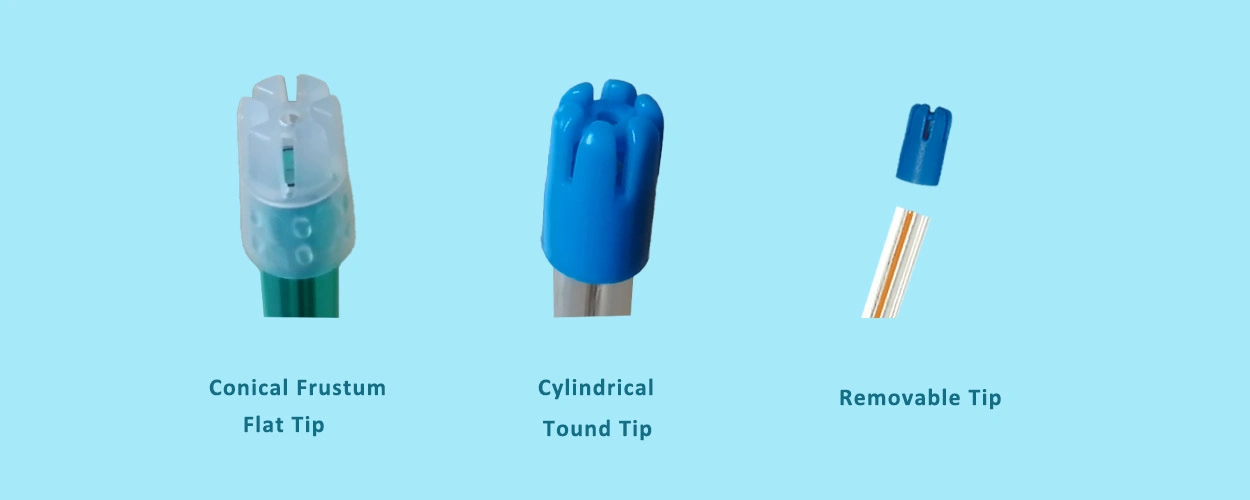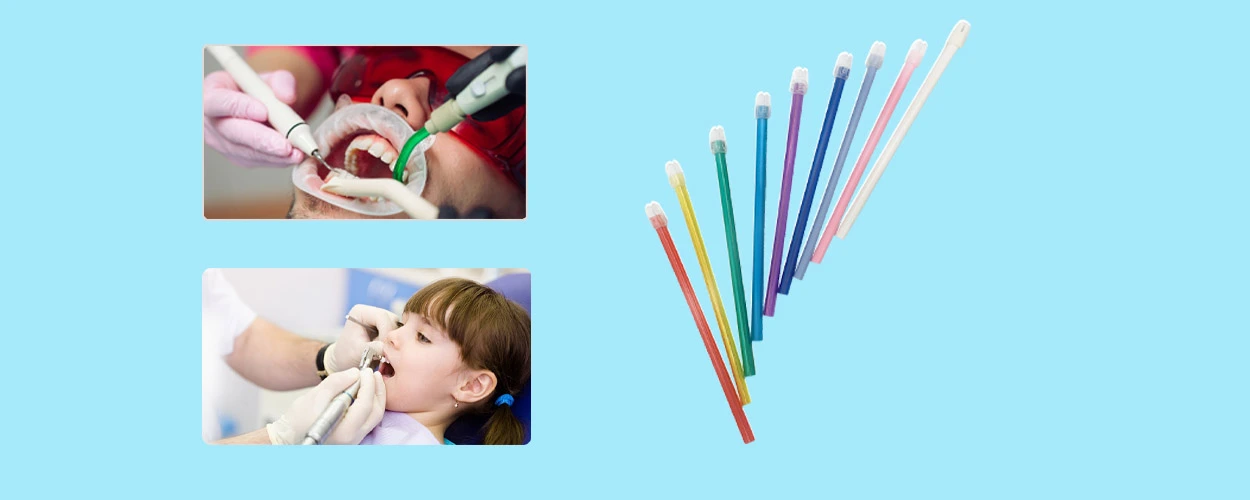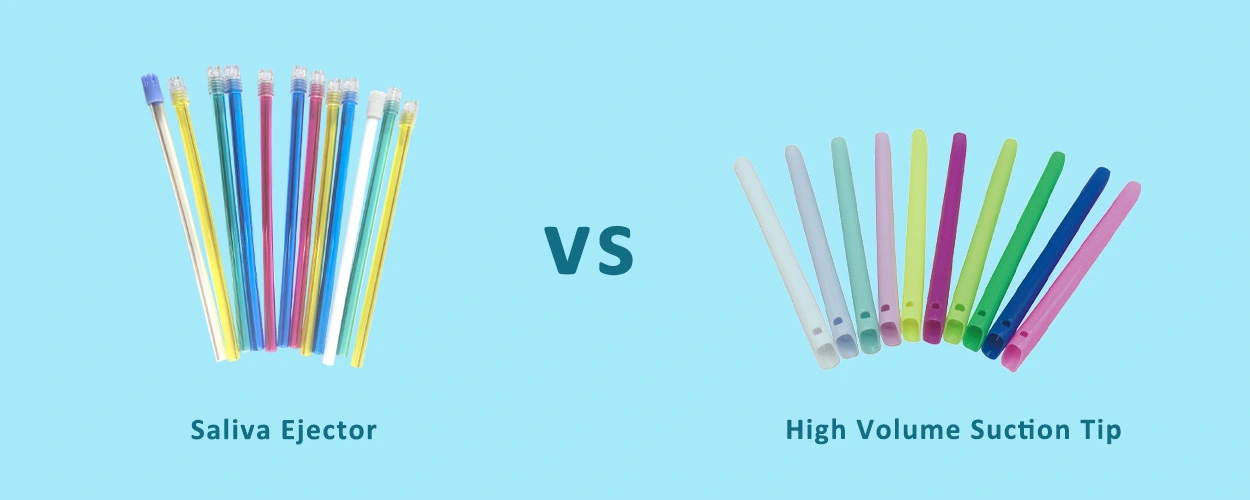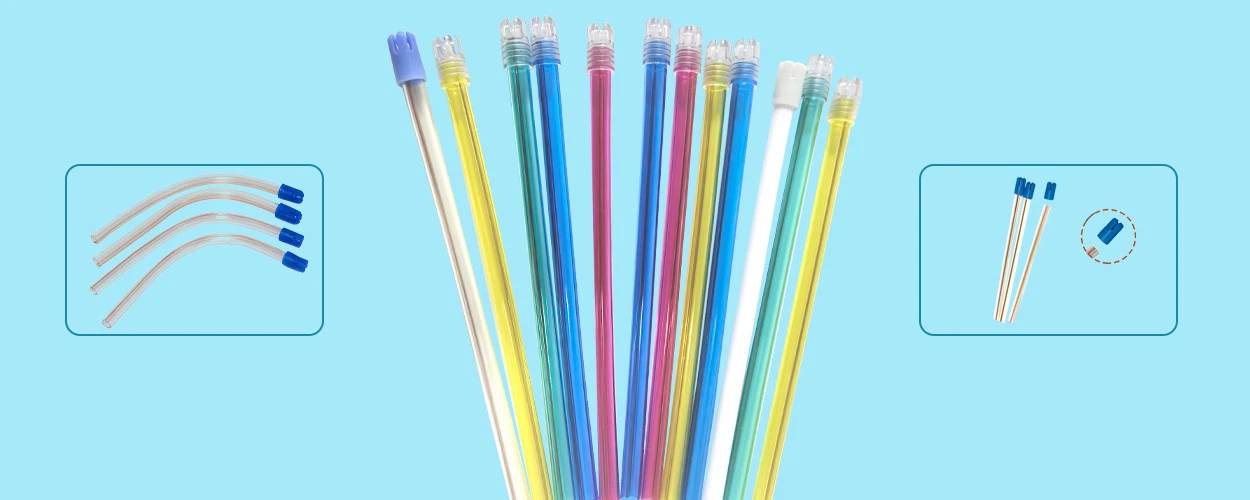Saliva ejector, the most common tool used in dental procedures, are found in almost all dental offices and dental hospitals. As a person working in the dental supply industry, I often have clients who say that they don’t know enough about saliva ejector and ask for my help. Now, through this article, we will introduce saliva ejector from all aspects and angles, so that you can know enough about it.
1. What is a saliva ejector?
saliva ejector is a kind of auxiliary tool used in dental treatment, the main role is to help keep the mouth dry, clear the operation field, reduce the interference of liquid accumulation on the treatment, improve the accuracy of treatment and patient comfort by sucking the saliva, blood, high speed handpiece cooling water in the patient’s mouth during dental surgery.
2. Material and structure of the saliva ejector
Saliva ejectors are constructed from medical-grade PVC and typically comprise a flexible tube with a detachable tip. Most saliva ejectors incorporate a metal line within the tube, allowing it to bend and maintain specific angles for navigating the confined and intricate spaces of the oral cavity. The tip design varies by therapeutic application, with common variants including rounded and flat profiles. The saliva ejector relies on the negative pressure provided by the suction device to draw fluids from the oral cavity into the tube, which is then diverted to a specialized collection system.
3. How many types of saliva ejector?
Saliva ejectors can be categorized into round and flat tip based on the shape of the head, which varies from manufacturer to manufacturer, ranging from cylindrical to conical frustum. According to the head design can be divided into fixed tip and removable tip. These are designed to accommodate different treatment options. According to the price, they can be categorized into Economy and Premium. All styles of saliva ejector can meet the needs of dental procedures, while the Premium model will be better in terms of material and detailing, and therefore slightly more expensive than the Economy model. The tubes are available in a wide range of colors, and custom colors are also available.

4. How does a saliva ejector work?
Core principle
Based on negative pressure suction, the system creates a controllable negative pressure environment within a sealed pathway when the suction device is activated. Through pressure gradient effects, it achieves directional transfer of oral secretions: saliva, blood, and tissue debris are rapidly drawn into the tube via the negative pressure inlet and transported through the pathway to a dedicated collection unit.
Intelligent pressure regulation system
The device features a stepless suction adjustment knob (0-100 kPa) with three preset modes:
- Sensitive mode (5-20 kPa): Designed for children and patients with mucosal sensitivity, ensuring painless suction.
- Standard mode (20-50 kPa): Meets routine dental treatment needs, balancing comfort and efficiency.
- High-power mode (50 kPa+): Tailored for surgical procedures, guaranteeing rapid fluid clearance.
**Clinical tip: A stepwise suction adjustment is recommended during initial orthodontic treatment phases to help patients gradually adapt to the device.
5. Application scenarios of saliva ejectors in different dental treatments
A. Preventive care scenarios
- Periodontal care: saliva ejector sucks up cooling water, gingival sulcus fluid and demineralized debris generated by the ultrasonic handpiece, maintaining the visualization of the operating space.
- Aesthetic restoration: Creates a Class IV dry environment (humidity <5%) during resin filling/veneer bonding, ensuring adhesive penetration depth of 50-100 μm.
B. Surgical-grade applications
- Complex tooth extraction: The saliva ejector can be used with a high-speed turbine handpiece to realize the “dry extraction technique, with a blood liquid removal rate of ≥200ml/min.
- Implant surgery: Collaborates with periosteal elevators to meet ISO Class 4 cleanliness standards (residual fluid <0.1 ml/cm²).
- Maxillofacial surgery: Utilizes anticoagulant-coated catheters for dual-channel dynamic suction in open-field procedures like tumor resection.
C. Specialty adaptations
- Pediatric dentistry: Employs detachable saliva ejectors with flexible silicone tips, reducing treatment interruption rates by 30%.
- Orthodontics: Precisely controls bonding area humidity to RH40%±5%, enhancing bracket initial adhesion strength to 22 N/cm².
- General anesthesia: Integrates anti-aspiration safety valves (response time <0.3 s) to prevent accidental inhalation and minimize patient discomfort.

6. Quality control and production standards for saliva ejector
As a medical device, saliva ejector must have strict quality control and production standards to ensure their safety, efficacy and quality. These standards include, but are not limited to: ISO 13485 FDA certification CE marking ISO 10993.
Each batch of tubes undergoes a number of quality tests before leaving the factory: dimensional accuracy tests, physical properties tests, suction tests, and durability tests.
Batch numbering and traceability: Each minimum packaging unit of saliva ejector should be labeled with a batch number to ensure that in the event of a quality problem, it can be traced back to a specific point in the production process.
7. Precautions for Using Saliva Ejectors
A. Operational techniques and positioning
- Use a grasping technique to position the saliva ejector near saliva accumulation areas adjacent to the treatment site (e.g., lingual or buccal sides of posterior molars), avoiding obstruction of the operator’s visual field.
- Adjust the assistant’s seat height to remain higher than the dentist, ensuring natural fluid flow downward while observing the patient’s head tilt for precise positioning.
- Maintain a stable posture during suction: tuck elbows close to the body and stand near the dental unit to ensure operational flexibility and clear visibility.
B. Mucosal protection and special patient care
- Avoid direct mucosal contact to prevent prolonged suction-induced trauma. Periodically reposition the tip or use intermittent “spot suction” combined with cotton roll buffering.
- For children or sensitive patients, reduce suction power to minimize pharyngeal irritation and mucosal bleeding risks.
C. Infection control and hygiene management
- Disposable saliva ejectors require plastic film sleeves covering the valve and lower 10 cm area. Replace immediately post-treatment to prevent cross-contamination.
- Discard used ejectors in designated medical waste containers following medical waste disposal protocols, ensuring they cannot be reused.
8. What are the CDC guidelines for using saliva ejectors?
Some components of dental instruments are permanently attached to dental unit waterlines and although they do not enter the patient‘s oral cavity, they are likely to become contaminated with oral fluids during treatment procedures. Such components (e.g., handles or dental unit attachments of saliva ejectors, high-speed air evacuators, and air/water syringes)
saliva ejector have been reported, practitioners should be aware that in certain situations, backflow could occur when using a saliva ejector.
Single-use devices in dentistry are usually not heat-tolerant and cannot be reliably cleaned. Examples include syringe needles, prophylaxis cups and brushes, and plastic orthodontic brackets. Certain items (e.g., prophylaxis angles, saliva ejectors, high-volume evacuator tips, and air/water syringe tips) are commonly available in a disposable form and should be disposed of appropriately after each use.
–Guidelines for Infection Control in Dental Health
9. Why does backflow occur when using a saliva ejector?
Inadequate suction equipment power, broken line seals, air leaks, and clogs can result in a negative pressure environment that cannot be stabilized. Which can cause the fluid that has entered the saliva ejector to reflux due to gravity or air pressure equilibrium. Backflow also occurs when the air pressure in the mouth is lower than that in the saliva ejector because the patient suddenly shuts up. This backflow is a potential source of cross-contamination and practitioners should be alert to this occurrence.
10. What is the difference between a saliva ejector and a high volume suction tip?
Saliva ejector and high volume suction tip are both commonly used suction accessories in dental treatment and serve much the same primary function; however, there are some significant differences in design, function and scenarios of use:
| saliva ejector | high volume suction tip | |
| Function and suction strength | relatively gentle suction force, suitable for routine operations to suck saliva, water mist or less viscous secretions, and at the same time can assist in moisture isolation or reduce aerosol contamination. | strong and concentrated suction, mainly used for rapid removal of blood, broken tooth roots, soft and rotten dentin and other large amounts of liquid or solid debris in oral surgery or complex operations. |
| Construction and design | Mostly a bendable hose made of polyvinyl chloride (PVC) plastic, with a smaller diameter (e.g. 4mm) and high flexibility, suitable for adjusting the angle to suit different areas. | usually non-bendable rigid tubes made of high-temperature resistant polyamide plastic (PA), with large diameters (e.g., 3.8 mm), suitable for precise suction of specific targets. |
| Scenarios of use | Used for less invasive treatments such as cleanings, fillings or sealing of sockets to remove saliva, cooling water and fine debris and to minimize irritation of the patient’s throat. | Commonly used in tooth extraction, implant surgery or dental preparation operations, which require rapid removal of large amounts of blood or debris to maintain a clear surgical field. |
| Suitability | disposable is more common, need to be coupled with cotton rolls or rubber barriers to isolate and reduce the risk of cross-infection. | some can be autoclaved and reused (e.g., made of PA) or are of a sterile, disposable design, and are strictly required to avoid contact with soft tissues to prevent injury. |
By adapting to different scenarios, the two can also be used in tandem to improve diagnosis and treatment efficiency and patient comfort.

11. Innovative technologies and future trends in saliva ejectors
- Application of biodegradable materials: Biodegradable materials such as PLA (polylactic acid) are used to make saliva suction tubes, which reduces the pollution of traditional plastics and is in line with the global trend of environmental protection policies.
- Improvement of flexible materials: Using softer PVC or PA materials balances durability and comfort and reduces irritation to the oral mucosa.
- Personalized fit design: Customized products with smaller tube diameters and lower suction power are available for groups such as children and sensitive patients.
- Anti-backflow and infection control: Reduce the risk of cross-infection by improving tube sealing and anti-backflow valve technology.
- Intelligent sensing technology: pressure sensors or flow monitoring modules may be integrated in the future to adjust suction power in real time to suit different treatment scenarios.
Conclusion
Saliva ejectors are vital dental tools that utilize negative pressure suction to manage oral fluids and debris, with adjustable modes for diverse clinical needs. Distinct from high volume suction tip, they offer gentler suction, flexible positioning, and disposable designs for low-invasive procedures. Critical precautions include proper placement, mucosal protection, and infection control to mitigate backflow risks.
References
Guidelines for Infection Control in Dental Health – RR5217 Dental Front (See pages 30-32 of the PDF document for details )


